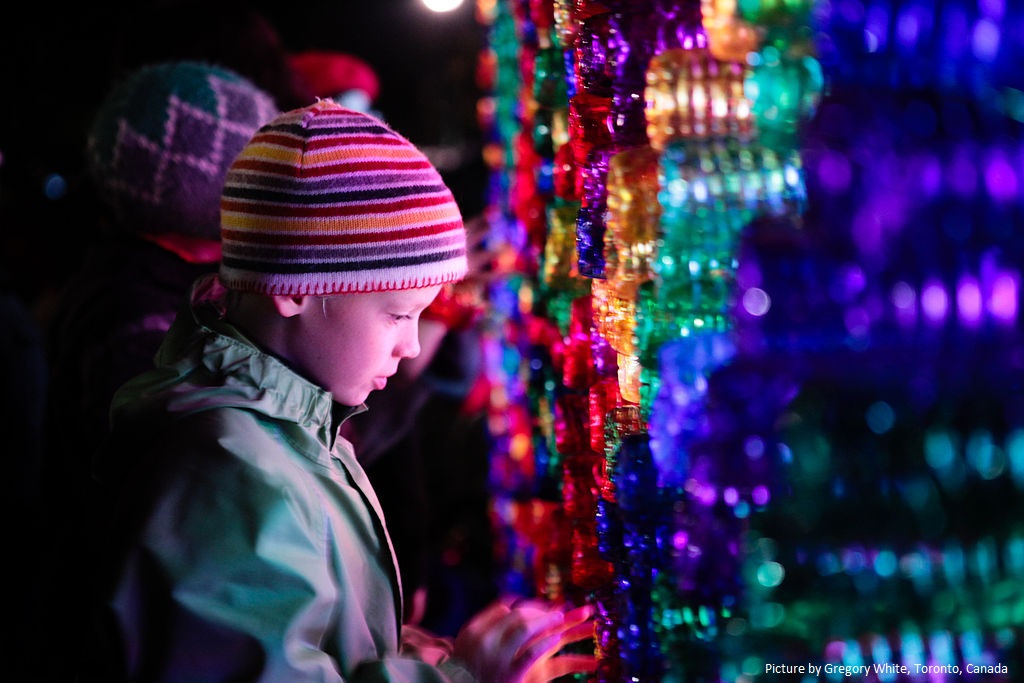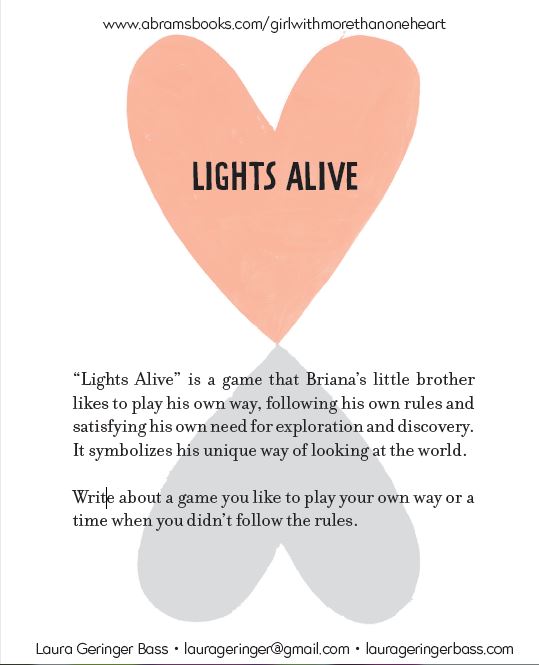
LIGHTS ALIVE! Why Telling Your Story Matters
Guest post by author Laura Geringer Bass.
There is a scene in my new middle grade novel, The Girl with More than One Heart, that is based on a real life parent conference I had once with my son’s kindergarten teacher. I called the chapter “Lights Alive” which is the name of a game my son liked to play when he was little on a plastic board made up of dots of colored light. The player selects and organizes the pinpoints of light into pictures and patterns. The game may be played by several children at once with each child contributing something to the final picture. When it is complete, the last child to take a turn cries, “Lights Alive!”
Lights Alive can also be played alone which is how my son liked to play it. The game encapsulates my memory of how it felt to be the parent of a son on the autistic spectrum.
“Your son is not good for this school,” his kindergarten teacher told me.
“Do you mean this school is not good for my son?” I asked.
“He needs a school where learning differences are the norm,” she said. “He’s not standard issue.”
“But he learned to read early,” I protested. “In your report you wrote he was one of the first in the class to read.”
“Yes, academically, he’s doing very well, but if you insist on keeping him in this school, he’ll have to repeat a grade,” she said, obviously thinking the shame of that pronouncement would send me scurrying away to seek shelter for my son elsewhere. “He’ll definitely need an extra year to mature socially.”
It took me a moment on that occasion to process the fact that my son’s teacher wanted my child out of her school. She found him labor intensive. She didn’t have the time or the energy to figure out his quirky responses to her directives, to think up strategies to teach him how to go with the flow, to help him ease up on the rigid internal limitations his social anxiety required and to encourage him to take the first steps toward making a friend.
To the teacher’s surprise, I agreed to my son repeating kindergarten. As long as he was assigned a different teacher, there was no harm in having him be the oldest instead of the youngest in his class, I reasoned. He could use some extra time to figure out how to make a friend.
The scene in my novel when the fictional version of my son gets left back includes an account of how, at the conference, he played the game, Lights Alive.
In real life, my son did not play the game at the kindergarten parent conference. In fact he wasn’t there at all. He did play the game by his own rules in school however. Not only did he not invite other children to take turns, but he left all the lights off as he created his design so they couldn’t see what he was doing–until the very end when with a flip of the switch he revealed a complicated pattern of his own creation. The illusion that it had sprung into being with no dot-by-dot build up at all was to him, magical.
My son could not have explained to his teacher who thought he didn’t understand the game, why he needed to leave the lights off as he selected the colors, why he didn’t allow himself or anyone else the opportunity of seeing them as he built them into a pattern, why he had a tantrum if she tried to get him to play the game with other children. I couldn’t have explained it to her either.
There was no road map I could have drawn for that teacher to let her know how she could help my son best navigate her classroom. When he had melt downs and I was called into school to pick him up and take him home I just had to keep what I came to think of as an open “Lights Alive” mind and an open loving heart and pray that would be enough. And pray too that others in positions of power over my son in the world outside our home would do the same.
In 2011, the term neurodiversity floated into popular consciousness. For the first time, autism was defined not as a disease or a disorder, not as a condition that must be (but tragically cannot be) cured but as an authentic manifestation of human diversity. It was a breath of fresh air to mothers like myself. My son could be successful in a world that accepted neurodiversity. In such a world, he could learn at his own pace without being labeled slow. He could grow and challenge himself without wasting energy on fitting into the mainstream or passing as normal. He could be himself.
It was at about that time that my son rejected the messy alphabet soup of diagnostic babble (HFA, PDD-NOS, SD, LD, etc.) we had been served by doctors and interpreters of standardized tests throughout his childhood and firmly announced that he was just a geek or if I preferred, a nerd.
“Isn’t geek a very uncomplimentary term?” I asked. “And nerd just slightly less so?”
“They used to be,” he said, “but not any more. “Technology has changed all that.”
“For the information age,” says Harvey Blume, “neurodiversity may be every bit as crucial for the human race as biodiversity is for life in general.”
What a far cry a neurodiverse inclusive world is from the one I faced in the late 1980s when an educator in a respected school told me with authority and no evidence of empathy that my son was not in her estimation “standard issue.”
“You’ve let the light in! ” exclaimed my wonderful editor Tamar Brazis when I showed her the revised and final draft of my book, THE GIRL WITH MORE THAN ONE HEART. My novel deals with some heavy issues like the loss of a parent and the difficulties of living with a child on the spectrum, but readers have said it’s a story full of hope, a story alive with light. A Lights Alive! story.
I certainly hope so.
My book has now drawn me into a personal mission—to help children write their own stories. It’s something I’ve been doing all my life but recently I created, with the support of First Book—an award-winning organization that has delivered over 175 million books to children in need around the globe– a #BeYourOwn workshop with writing prompts based on my book. I’ve been visiting schools and libraries and non-profits like Girls Write Now with prompt cards like this one:

and working with preteens and teens, many of whom feel alone or lost after a crisis of loss – or at a loss to understand what they see happening to other children in the world around them.
Watch Laila Dola, a second year Girls Write Now mentee use the #BeYourOwn workshop prompt, “Starry Ball” to tell her story, “The Forgotten Message.” It’s a timely and timeless message. I promise you won’t regret the few minutes you spend listening.
If you work with children in need and children with special needs and you’d like a set of #BeYourOwn prompt cards to help empower the children you support in your lives to tell their own stories, visit the First Book Marketplace listing of The Girl with More than One Heart to download the #BeYourOwn workshop here.
